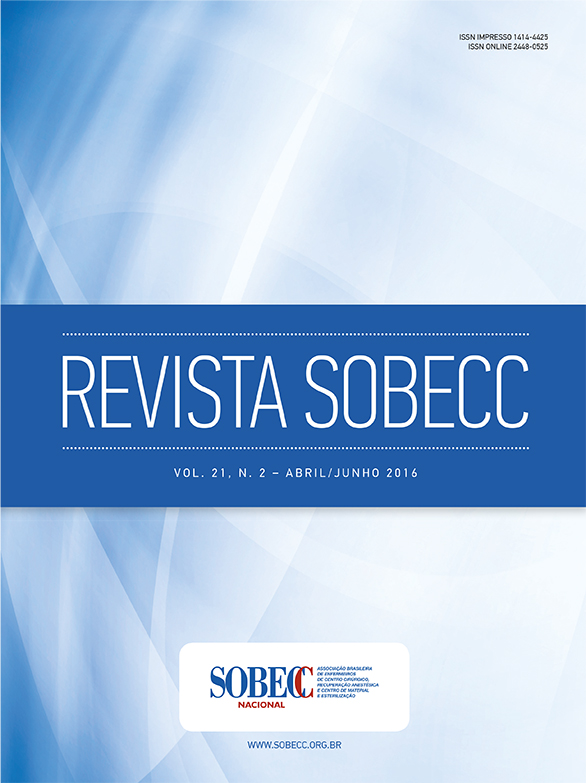Implementation of alcohol-based surgical hand antisepsis: experience report
DOI:
https://doi.org/10.5327/Z1414-4425201600020009Keywords:
Antisepsis. Infection. Nursing.Abstract
Objective: To describe the experience of surgical alcohol-based antisepsis on hand preparation of the surgical team. Method: Reporting the experience on deployment of alcohol solution for surgical hand antisepsis to replace brushing, during December 2014–July 2015. Results: Product was selected upon documentation analysis and application trial. Alcohol-based antisepsis was offered as alternative to the use of brushes impregnated with antiseptic. Scientific papers and advertising posters were available to the professionals. A total of 282 procedures were observed. The adherence rate to the alcohol solution ranged from 33% in the month of implementation to 54%, and compliance to the proper technique was observed in only 35.8% of cases. Conclusion: There was considerable adherence to the alcohol-based solution; it was observed as well economic impact and increasing of training demand for the right technique. There is a need to identify motivation factors and barriers for the successful implementation of this technology.References
Anderson DJ, Podgorny K, Berríos-Torres SI, Bratzler DW, Dellinger eP, Green l, et al. Strategies to prevent surgical site infections in acute care hospitals: 2014 update. Infect Control Hosp epidemiol. 2014;35(6):605-27.
Mangram aJ, Horan TC, Pearson Ml, Silver lC, Jarvis WR. The hospital infection control practices advisory committee. Guideline for prevention of surgical site infection. Infect Control Hosp epidemiol. 1999;20(4):247-80.
Widmer aF, Rotter M, voss a, Nthumba P, allegranzi B, Boyce J, et al. Surgical hand preparation: state-of-the-art. J Hosp Infect. 2010;74(2):112-22.
Graf Me, Machado a, Mensor ll, Zampieri D, Campos R, Faham l. antissepsia cirúrgica das mãos com preparações alcoólicas: custoefetividade, adesão dos profissionais e benefícios ecológicos no cenário da saúde. J Bras econ Saúde. 2014;6(2):71-80.
agência Nacional de vigilância Sanitária. Ministério da Saúde. Manual de segurança do paciente: higienização das mãos em serviços de saúde. Brasília: anvisa/MS; 2008 acesso em 2015 out 30. Disponível em: http://bvsms.saude.gov.br/bvs/publicacoes/segurancapaciente servicossaudehigienizacaomaos.pdf
World Health Organization. WHO guidelines on hand hygiene in health care. First global patient safety challenge clean care is safer care. Geneva: WHO; 2009 acesso em 2015 out. 20. Disponível em: http:// apps.who.int/iris/bitstream/10665/44102/1/9789241597906 eng.pdf
Boyce JM, Pittet D; Healthcare Infection Control Practices advisory Committee; HICPaC/SHea/aPIC/IDSa Hand Hygiene Task Force.. Guideline for hand hygiene in health-care settings: recommendations of the Healthcare Infection Control Practices advisory Committee and HICPaC/SHea/aPIC/IDSa Hand Hygiene Task Force. MMWR Recomm Rep. 2002;51(RR-16):1-45.
Gruendemann BJ, Berke NB. Is ti time for brushless scrubbing with an alcohol-bases agent? aORN J. 2001;74(6):859-73.
Gonçalves KJ, Graziano Ku, Kawagoe J. Revisão sistemática sobre antissepsia cirúrgica das mãos com preparação alcoólica em comparação aos produtos tradicionais. Rev esc enferm uSP. 2012;46(6):1484-93.
allegranzi B, Nead SB, Combescure C, Graafmans W, attar H, Donaldson l, et al. Burden of endemic health-care-associated infection in developing countries: systematic review and metaanalysis. lancet. 2011;377(9761):228-41.
Olson lK, Morse DJ, Duley C, Savell BK. Prospective, randomized in vivo comparison of a dual-active waterless antiseptic versus two alcohol-only waterless antiseptics for surgical hand antisepsis. am J Infect Control. 2012;40(2):155-9.
Parienti JJ, Thibon P, Heller R, le Roux , von Theobald P, Bensadoun H, Bouvet a, et al. antisepsie Chirurgicale des mains Study Group. Hand-rubbing with an aqueous alcoholic solution vs traditional surgical hand-scrubbing and 30-day surgical site infection rates: a randomized equivalence study. JaMa. 2002;288(6):722-7.
Downloads
Published
How to Cite
Issue
Section
License
By publishing in Revista SOBECC, authors retain the copyright of their article and agree to license their work using a Creative Commons Attribution (CC BY 4.0) International Public License, thus accepting the terms of this license. The CC BY 4.0 license allows others to distribute, remix, adapt, and create from the published article, even for commercial purposes, provided they give due credit to the creators of the work (authors of the article).
The authors grant to Revista SOBECC the right of first publication, to identify itself as the original publisher, and grant to the journal a non-exclusive license to use the work in the following ways: (1) to sell and/or distribute the article in hard copies and/or in electronic format; (2) to distribute parts and/or the entire article in order to promote the journal through the internet and other digital and printed media; (3) to record and reproduce the article in any format, including digital media.
With this license, authors can enter into separate contracts for non-exclusive distribution of the article (e.g., publishing in an institutional repository or as a book chapter), with acknowledgement of authorship and initial publication in Revista SOBECC. Authors are encouraged to publish and distribute their work online after publication in the Revista SOBECC, as this can increase the article's visibility and impact.
In line with the journal's policies, each published article will be assigned a CC BY 4.0 license, which will be visible on the abstract page and in the PDF of each article with the respective link to the license terms.











